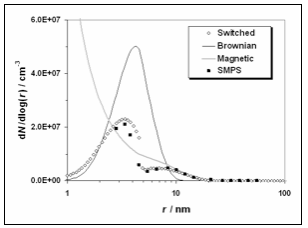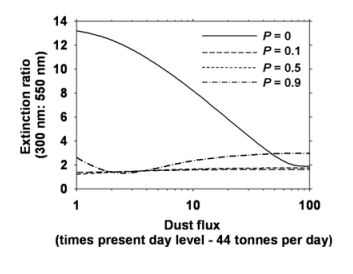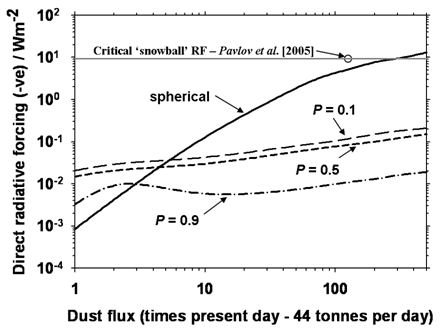Growth modelling of fractal, magnetic particles
Middle/Upper Atmosphere Modelling, Past Research.
The formation of the extended particle structures from an aerosol flow reactor (see laboratory section) is most readily explained in terms of long-range magnetic dipole (particle) interactions arising from the amorphous Fe-based mineral structures.1
Time-resolved size distribution data was used to develop a growth model based upon both Brownian, diffusive coagulation at small particle sizes (< the primary particle radius, r0) and magnetically-controlled coagulation between particles of r ≥ r0 , see Saunders and Plane 1 for more details. Figure 1 shows the model best-fit to a single growth time from the laboratory measurements for fayalite (Fe2SiO4) particles. The fit was obtained with a fractal dimension (Df) = 1.75, r0 = 4.6 nm and by assuming the degree of magnetic dipole alignment within the particles was 24 percent.
 Figure 1. Modelled best-fit (labelled 'Switched') and measured ('SMPS') fayalite particle size distributions. The other plots are obtained by assuming only diffusional ('Brownian') or only magnetically controlled ('Magnetic') coagulation between particles - Figure taken from Saunders and Plane (2006).
Figure 1. Modelled best-fit (labelled 'Switched') and measured ('SMPS') fayalite particle size distributions. The other plots are obtained by assuming only diffusional ('Brownian') or only magnetically controlled ('Magnetic') coagulation between particles - Figure taken from Saunders and Plane (2006).
Earth's Paleo-Atmosphere
Another aspect of MSP's we have investigated is the potential impact of the presence of such aerosol particles on the Earth's climate throughout the planet's geological past. Specifically, we've looked at the possible radiative consequences of elevated smoke particle concentrations in the atmosphere during periods of enhanced cosmic dust flux in ancient times, as evidenced by a number of isotopic analyses of rock and sediment strata.2 In particular, we have considered; (1) a possible role as a UV barrier prior to the establishment of the stratospheric ozone layer and (2) initiation of the two major glaciation periods resulting in the snowball Earth scenario.3
Using a one-dimensional model which treats fractal growth resulting from the magnetic particle coagulation process described previously, and sedimentation from 110 km - 20 km altitude at 1 km resolution, smoke particle profiles (concentration per cm-3 versus altitude) were generated from a range of initial dust input levels covering three orders of magnitude above the present day flux (PDF), taken to be 44 tonnes per day. From these profiles, the total light extinction (or optical depth) and the direct radiative forcing (DRF) caused by the presence of either; (i) spherical and compact or (ii) fractal and porous meteoric smoke particles in the atmosphere were determined.4 In all cases, a particle composition of fayalite (Fe2SiO4) was chosen.
 Figure 2 gives the integrated (altitude and particle size) UV: visible extinction ratio values over a range of dust fluxes. Consideration of a fractal, porous nature for the particles results in low ratios at all flux levels. This would strongly disfavour any likely role for MSP's as an effective UV barrier to the surface.
Figure 2 gives the integrated (altitude and particle size) UV: visible extinction ratio values over a range of dust fluxes. Consideration of a fractal, porous nature for the particles results in low ratios at all flux levels. This would strongly disfavour any likely role for MSP's as an effective UV barrier to the surface.
 Figure 3 shows the variation in evaluated DRF values with dust flux. The plot also shows a 'critical forcing' level determined by Pavlov et al (2005), above which global ice coverage would have ensued assuming present day surface temperature and ice-coverage. Clearly, the scenario of fractal growth suggests that a much reduced forcing would be caused by smoke particles which consequently would be predicted to have little involvement in the snowball Earth episodes unless their potential for activation of ice nucleation in the atmosphere led to significant indirect radiative forcing (Saunders et al., 2007). We are currently investigating this particular property of the MSP analogues (see Laboratory section)
Figure 3 shows the variation in evaluated DRF values with dust flux. The plot also shows a 'critical forcing' level determined by Pavlov et al (2005), above which global ice coverage would have ensued assuming present day surface temperature and ice-coverage. Clearly, the scenario of fractal growth suggests that a much reduced forcing would be caused by smoke particles which consequently would be predicted to have little involvement in the snowball Earth episodes unless their potential for activation of ice nucleation in the atmosphere led to significant indirect radiative forcing (Saunders et al., 2007). We are currently investigating this particular property of the MSP analogues (see Laboratory section)
References
- Saunders, R.W., and Plane, J.M.C., A laboratory study of meteor smoke analogues: composition, optical properties and growth kinetics. J. Atmos. Solar-Terr. Phys., 2006c, 68, page 2182.
- Schmitz, B., et al., Accretion rates of meteorites and cosmic dust in the early Ordovician, Science, 1997, 278, 88-90.
- Hoffman, P.H., et al., A Neoproterozoic snowball Earth, Science, 1998, 281, 1342-1346.
- Saunders, R.W., Forster, P.M. and Plane, J.M.C., Potential climatic effects of meteoric smoke in the Earth's paleo-atmosphere, Geophys. Res. Lett., 2007, 34, L16801.
- Pavlov, A.A., et al., Passing through a giant molecular cloud: "Snowball" glaciations produced by interstellar dust, Geophys. Res. Lett., 2005, 32, L03705.
